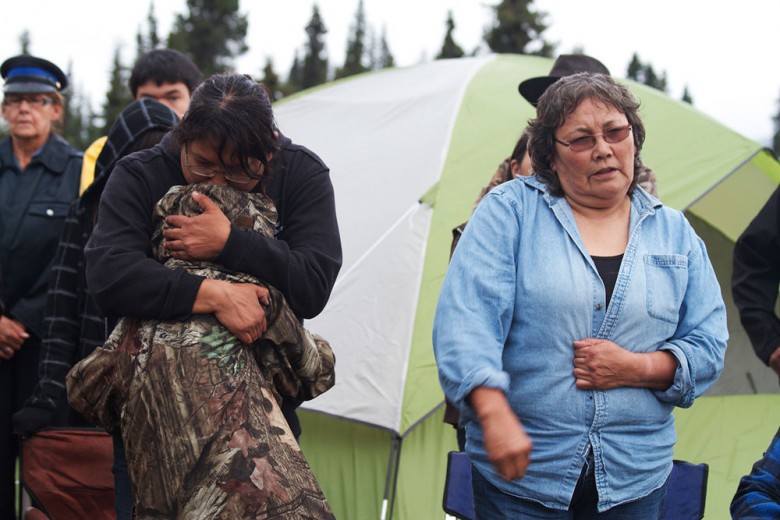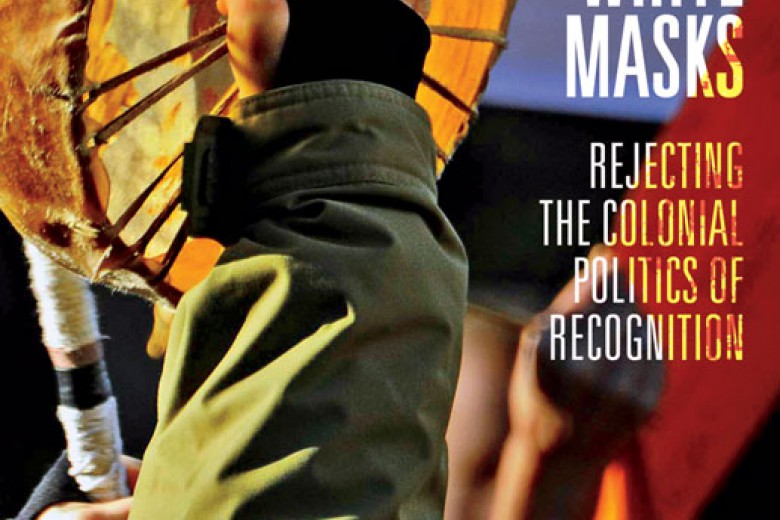It is a brutally cold January morning in Kingston, Ontario, traditional Anishinaabe and Haudenosaunee territory, and more than 100 people are huddled together around an enormous statue in a park near the downtown. It’s a mixed crowd, with everyone from anarchist punks to elderly ladies in attendance. A few have even donned what appears to be traditional 19th-century garb, complete with petticoats and bonnets. A slow rhythm builds in the distance, and gradually several drummers enter the open space at the foot of the statue.
A solemn, cloaked figure follows, wearing a hood over his face and noose around his neck. He faces the statue. There are chuckles as the hooded figure attempts to communicate with the statue by placing a telephone made of string and tin cans up to its ear.
The statue is of Sir John A. Macdonald, best known as Canada’s first prime minister and lesser-known for his pivotal role in constructing Canada as a colonial state premised on the genocide of Indigenous peoples. The hooded figure, we come to understand, is Louis Riel, the founder of Manitoba and the Métis leader who led his people in two uprisings against the Canadian government. He was executed by Sir John A.’s government in Regina in 1885.

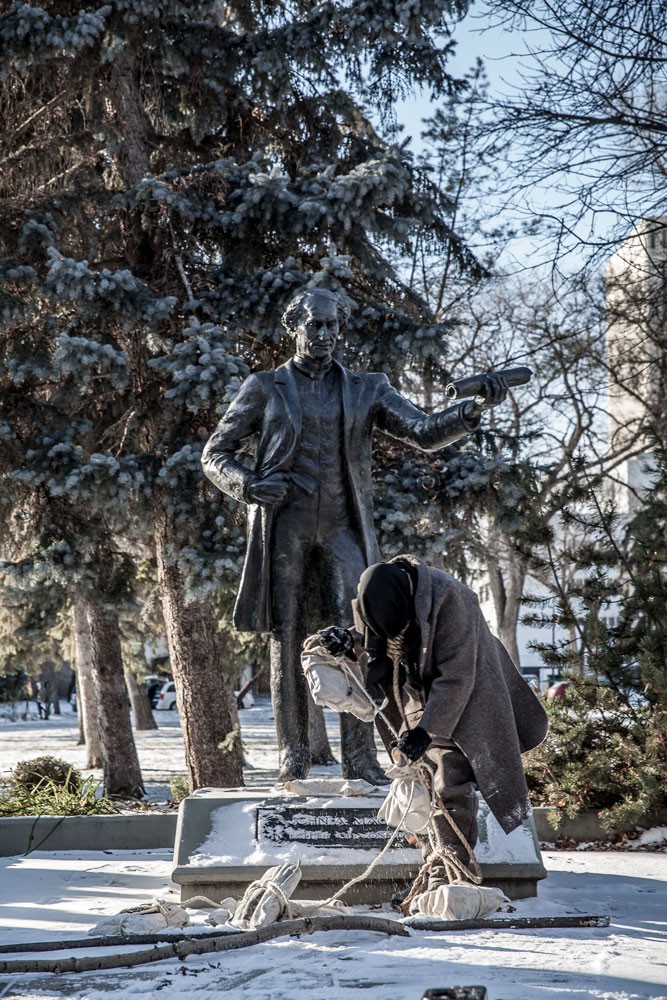

The Kingston performance, Dear John; Louis David Riel, was conducted by Métis artist David Garneau as part of curator Erin Sutherland’s Talkin’ Back to Johnny Mac performance series intended to intervene in the official celebration of Sir John A.’s 200th birthday. Sir John A. began his political life in Kingston and he plays a major role in the city’s popular imagination and tourism, with roads, schools, historic buildings, statues, and pubs honouring his legacy. The Sir John A. industry got a major boost this year, kicking off with “Macdonald Week” in early January.
Recognizing the cultural power of such celebrations, artists like Sutherland and Garneau have decided to unsettle them. Sutherland, who is Métis, has struggled to locate funding for her curatorial project, which will challenge Sir John A.’s legacy through specific performances from five Indigenous and settler artists over the course of the year. The Gertrudes music collective, in collaboration with poet Sadiqa Khan and Métis filmmaker Amanda Strong, created a song and music video to explore what it took to build “one almighty nation.” Paul Carl, an Indigenous community member of Algonquin and Oneida ancestry, and Laura Murray, a cultural studies professor at Queen’s University, both members of Kingston’s Municipal Heritage Committee, have used the opportunity to take aim at public art, and to ask what would happen if Indigenous histories were given as much attention as one genocidal politician.
Why art?
“Art gives people the opportunity to question what they’ve been taught,” says Sutherland. “And it makes politics accessible. I‘m not a political person, but art makes politics understandable and interesting to talk about. A lot of the things I have learned about Indigenous politics are from art.”
This accessibility is one of the things that makes art such an important political tool.
“There’s something special about a song, as opposed to an editorial or a talk. Most people are comfortable with music because of the way it permeates our culture,” says Greg Tilson, a singer and guitar player with The Gertrudes. They strategically set their song to a traditional Irish drinking tune to take advantage of this accessibility. “We thought that it would be cool if we wrote a song that people with their beer steins could sing along to, but that actually had this really critical message.” The song’s video features a Sir John A. doll that was used in the city’s commemorative activities set next to arresting images of residential schools.
Art implicates its audience in a way that straightforward information sometimes can’t. “I like the provocativeness of art,” Garneau says. “It provokes ideas, feelings, and sensations but cannot quite be held to account because we are aware of how much we are implicated in the meaning making.”
These artistic interventions raise questions about who we are as people living on this land and the kind of communities we want to create moving forward. “Art is concerned with the symbolic realm, with influence, with reshaping our individual and collective imaginaries,” Garneau contends. “This in turn remodels behaviour and policy.” Thus, beyond its critical function, art helps us to imagine and even create futures beyond colonialism.
Macdonald’s legacy
Now you cannot be squeamish if you wish to build a nation
Sir John A. and his colleagues tried the method of starvation
And the Native children that he would soon be ruling
He sent them off to learn his ways in the residential schooling
– “Of One Almighty Nation” by The Gertrudes, with lyrics by Sadiqa Khan
As a key player in the signing of the British North America Act, as Canada’s first prime minister, and as the man credited for the national railway that unified the new nation, Sir John A. is typically glorified as one of Canada’s founding heroes.
What is less well-known is that, while prime minister, Sir John A. simultaneously served as minister of Indian Affairs – a double-barrelled portfolio of strategic importance. For there was one major barrier to be taken care of before Sir John A. could achieve his dream of a new country that stretched from sea to sea: the people who already lived here.
In the Prairies, these inconvenient people were handled via the numbered treaties, in which Indigenous peoples exchanged their inherent rights to the land for small parcels of it called reserves. In many cases, people were not eager to sign away their rights to the land and did so only under duress. This was the case with Treaty Six, which was signed in the face of the drastic decline of the bison population. Faced with food shortages, the Plains and Woods Cree, among others, signed the treaty in exchange for a commitment that the Canadian government would provide them with humanitarian food aid.
But as historian James Daschuk carefully documents in his celebrated book Clearing the Plains, Sir John A. ruthlessly limited the amount of food aid, keeping Indigenous populations on the brink of starvation. “In 1878 there was a full-on famine, and Sir John A. ordered the Mounties to withhold food until people moved to their appointed reserves,” Daschuk explains. “So chiefs were forced to exchange their freedom for food.” With the near-eradication of the bison, Sir John A. intentionally starved Indigenous people onto reserves, and even there, food rations were so inadequate as to result in decreased immunity and increased susceptibility to disease.
This is how the path for Sir John A.’s railway – built by hyper-exploited Chinese immigrants and used to carry troops to suppress the Métis resistance – was cleared.
For many Canadians, the direct relation between Sir John A. and colonialism begins and ends with Louis Riel, but the historical reality is much different. “Riel and Macdonald are kind of pitted against each other,” says Sutherland, “but this ends up overshadowing other Indigenous issues, and makes them seem like a thing of the past. But these issues are ongoing.”
Among these ongoing issues are policies like the Indian Act, which was introduced by Sir John A.’s government in 1876 and made Indigenous people wards of the Canadian state. It also defined who qualified as a “status” Indian, and who was therefore eligible for benefits. Sir John A. is also the man responsible for introducing residential schools, institutions now infamous for cultural genocide, physical and sexual abuse, and intergenerational trauma.
These legacies are rarely acknowledged by any of the public monuments commemorating Sir John A., a fact pointed out by Carl and Murray in their quest to imagine how heritage activities might look different. By creating alternative mock plaques that call attention to both the darker side of Sir John A. and to Indigenous histories, they highlight the ways public art might help us better reflect on both the past and the present. In one proposed plaque, they contrast the building of Kingston’s Sir J. A. Macdonald Public School in Kingston – which provoked major complaints after opening one year late – with the situation in Attawapiskat First Nation.
The school in Attawapiskat was closed in 2000 after being declared toxic because of a diesel leak. After years of lobbying , a new school (called Kattawapiskak) finally opened in 2014. Regarding Kingston’s new school, Carl says, “Naming your school after Sir John A. is pretty offensive, when you start thinking about education for Indigenous peoples. We still live with the effects of Sir John A.’s policies: the residential school survivors, the prisons, the Indian Act, the Métis … it’s all still alive.”
After his failed attempt to communicate with the Sir John A. statue via can-and-string telephone in the Kingston performance, Garneau’s character burns sweetgrass and dons an Idle No More T-shirt. Garneau says the performed figure then shifts from the dead Louis Riel “to a contemporary Métis who turns his back on Macdonald and all he represents, and re-engages Indigenous practices and worldview.”

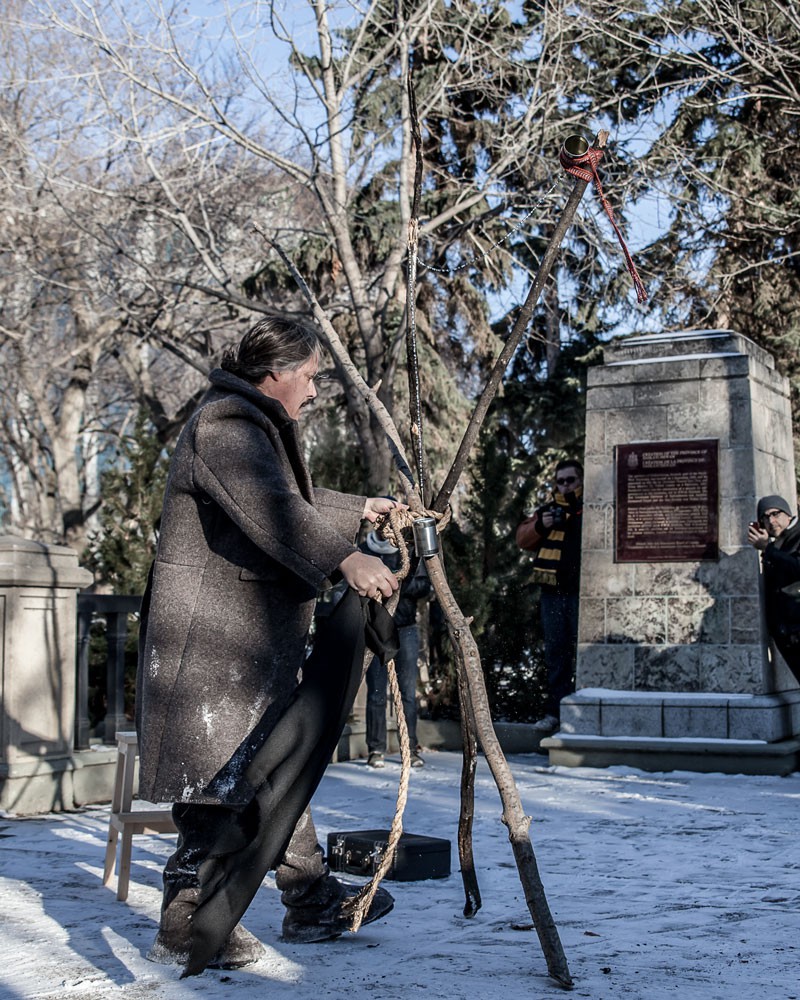
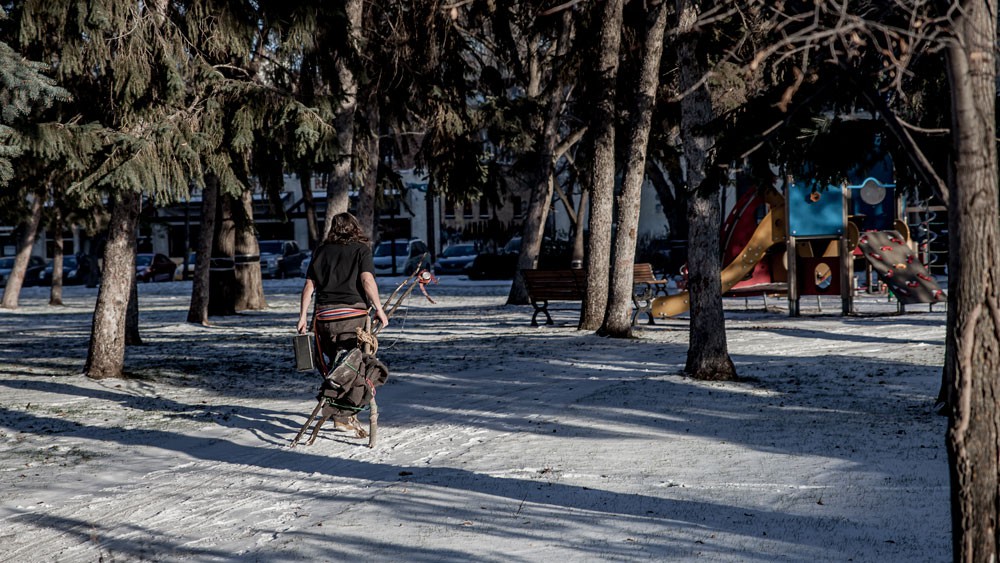
This is how history is written
Performances like Garneau’s, while perhaps small in the context of the many official celebrations of Sir John A., nevertheless impact our cultural imagination. When asked what inspired The Gertrudes’ song about Sir John A., Tilson tells me, “I just had a bit of an epiphany with the bicentennial, that this is how history is written: here comes the money, the biased school curriculum, the tourist packaging. I got thinking about who was telling the story and who was and wasn’t involved in the conversation. It was a reminder for me of who has the power, and we wanted to do something small to change the conversation.”
In the context of ongoing colonialism in Canada, it is Indigenous peoples who have been systematically denied power, and the right to be included in – let alone to guide – the conversation. This is despite the fact that, as Carl notes, settler histories are little more than a “blip” in the bigger picture: “In the grand scheme of things, Kingston has been here maybe 300 years; Sir John A. was born 200 years ago. But we’ve been here thousands of years.”
While Kingston has 11 plaques dedicated to Sir John A., there is no public recognition of Peter E. Jones, a contemporary of Sir John A. and one of the first status Indians to obtain a university education after attending Queen’s University medical school. Jones became an advocate for health and education services for Indigenous peoples.
“Even if nobody reads them, these plaques are permanent inscriptions on the landscape and assert a kind of ownership,” says Murray. “They are like planting a flag. They enforce a reading of the land.”
Indigenous art produced by people like Sutherland and Garneau makes space for Indigenous bodies and their presence on this land. “Because colonialism has so much to do with the erasure of Indigenous presence, performance art can bring a feeling of belonging to a space,” says Sutherland. “David wasn’t Louis Riel, but he is an Indigenous person in a colonial space. Indigenizing art is a really great way to make space for ourselves.”
Garneau agrees, asserting that Indigenous art has transformative potential that extends beyond mere inclusion within liberal multiculturalism. “Indigenous art made without regard to dominant practice is radically unsettling to Canadians because it exists apart [from], without, and despite them, and is therefore a model for sovereignty.”
Given the strong currents of resistance running through these projects, it isn’t surprising that both Garneau’s performance and The Gertrudes’ video created by Amanda Strong conclude with nods to Idle No More. “The one thing that is really positive is the contemporary resistance of Indigenous peoples,” says Tilson. “Idle No More is perhaps the most inspiring grassroots movement I’ve seen in my lifetime. To put Sir John A. history in the context of that is really powerful.”
All the artists agree that the importance of such art lies in its ability to provoke reconsideration of our identities and relationships, to the land and to each other. “Refiguring Riel and Macdonald is not so much about them as about us, how we want to figure ourselves into the future,” Garneau affirms. Artistic engagements with history help us to imagine how more just, decolonized futures might look.



_780_520_90_s_c1.jpg)
